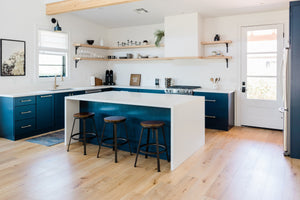Understanding State Building Codes for Range Hoods
Building codes vary from state to state, and in some cases from city to city. Those codes can impact all sorts of home improvement tasks, including range hood installations.
Don’t worry—installing a range hood is nothing like major structural renovations in terms of red tape. Range hood requirements are more straightforward than major home improvement jobs, but they can vary depending on state and local laws. For example, San Francisco has its own set of building codes that supersede California building codes for range hoods.
That’s why we recommend speaking with a local licensed contractor or someone at your city’s building code office.
Of course, you’ll want to ask the right questions and understand the important topics surrounding range hood codes before you have that conversation. And that’s why we’ve written this quick guide—so you can have an informed conversation with your contractor.

What Do Building Codes Regulate?
When it comes to range hoods, state and local building codes might affect a number of different aspects of range hood installation and performance.
Most of these don’t relate to the range hood unit itself, but instead address the work surrounding its installation. The one exception is airflow, which is measured in Cubic Feet per Minute (CFM). Since CFM regulations are key to your range hood buying decision, we’ll go deeper into that below, but first let’s talk about installation.
Building code regulations related to range hood installations may include the following.
Mounting Height and Clearance
Codes often require range hoods to be mounted at a specific distance above the stovetop to ensure proper ventilation while avoiding fire dangers.
Codes will vary depending on state and city requirements. For example, the California Mechanical Code (CMC) 920.3 – 920.4 requires a range hood and microwaves to be mounted at a minimum distance of 24 inches above the stove—even more if materials are combustible (see next section).
Municipal codes often exist that supersede state requirements, and many of them are based on something called the International Residential Code (IRC), which places the safe distance at 30 inches.
Again, be sure to check with a qualified contractor or your city’s code enforcement department to assess your specific requirements.
Clearance from Combustibles
The hood usually needs to be mounted at a safe distance from potentially combustible surfaces, such as cabinets and walls.
As with the mounting requirements mentioned above, regulations will vary from state to state and city to city. For example, many building codes in Texas, such as Dallas building code requirements, follow the International Residential Code mentioned above.
Oftentimes, anything made of combustible material is required to have an additional 6-inch clearance above what a typical code requires (such as the CMC 920.3 - 920.4 cited above)—bringing the total clearance requirement to 30 inches for California and other states.
Ductwork & Ventilation
Proper ductwork ensures healthy, effective ventilation. This includes factors like minimum duct sizes, allowable bends and lengths, etc.
Most codes require kitchen exhaust ducts to be constructed of smooth-walled, noncombustible materials (galvanized steel, stainless steel, or copper). Flexible or plastic ducts are not permitted (except in a special case for downdraft cooktops, where Schedule 40 PVC is allowed if buried under a slab with specific conditions).
Duct diameter must be at least as large as the hood’s outlet and installed per manufacturer’s specifications to ensure adequate airflow.
Electrical safety
All electrical components and lighting must comply with electrical codes relating to things like wiring, connections, etc. For example, most states permit homeowners to use hardwired connections or plug-in connections using the standard 120 V, 60 Hz supply for residential range hoods.
Once again, be sure to check with a licensed contractor or your local city’s building enforcement team before installing your range hood, just in case there are additional codes we haven’t mentioned here—or in case those codes we’ve highlighted are more complicated than they seem at face value.
Airflow Regulations (CFM) and Makeup Air Units
The biggest question we get here at Haulsane is about airflow regulations, and this deserves its own section because it’s a bit confusing at first glance.
Never fear, though! We’re here to break it all down for you.
What is airflow? Airflow measures the volume of air your range hood sucks up and removes from your home, and it’s measured in Cubic Feet per Minute (CFM).
Why do some state building codes care about airflow? While not all states regulate CFM, some do so because pulling too much air, too fast, can create negative air pressure in a home. In order to avoid this, some states require the installation of a makeup air unit for range hoods with higher airflows.
Laboratory CFM: The Only Rating that Matters for Inspectors
Let’s say your inspector tells you that your range hood can’t go over 600 CFM, so you look at the tech specs on Hauslane’s WM-540SS-30 Range Hood and see it has two different CFM ratings—laboratory CFM and Equivalent CFM.
Laboratory CFM refers to the measurement taken in a closed, carefully controlled environment. Equivalent CFM is a measurement that the industry uses to compare the effectiveness of each model when factoring in things like blower performance and other features that boost each unit’s efficiency.
Search Tip: Want to learn more about CFM? Take a look at our blog post about the differences between laboratory CFM and Equivalent CFM, along with our post about choosing a range hood with the right CFM for your kitchen.
Airflow Regulations for Specific States
California Building Codes
California building codes require a makeup air filter when a unit exceeds a 400 laboratory CFM, based on CA Energy Code 24, which includes the California Mechanical Code (based on the Uniform Mechanical Code).
Local jurisdictions in California are not allowed to weaken Title 24 requirements, but many have specific regulations that follow their own municipal codes.
Texas Building Codes
Texas has no universal statewide residential code, but based on our research, every major city and many counties adopt IRC or International Mechanical Code (IMC) standards. That means that most Texas cities require units with greater than 400 CFM to use makeup air units.
Washington State Building Codes
Washington state requires makeup air units for range hoods with 400+ CFM according to 2018 WA State Residential Code M1503.4, with specific requirements for cities like Tacoma, Seattle, and others. Be sure to consult a licensed contractor in your area.
New York State and New York City Building Codes
The 2020 New York Mechanical Code applies to all jurisdictions except New York City, requiring range hoods with a CFM of 400+ to include makeup air units. New York City, on the other hand, requires makeup units for all range hoods, regardless of their power. Consult your local code enforcement office or a licensed contractor.
Michigan Building Codes
The state of Michigan also enforces the 400 CFM threshold for makeup air requirements, according to MRC 2015 Section M1503.4. Local jurisdictions can vary, but they cannot be weaker than state-wide regulations.
In general, most states adopt the 400 CFM threshold, but some states and cities differ. At the risk of sounding like a broken record, you should consult a licensed contractor or your city’s code enforcement office to be sure, since these rules are often complex and always subject to change.
CFM and Performance: Is Higher Always Better?
It’s easy to assume that CFM tells the whole story, but there are many other factors related to keeping your indoor air clean.
All Hauslane range hoods are designed for optimal performance, and you can achieve clean kitchen air even if you don’t want to purchase a makeup air unit and your state’s building codes demand a lower CFM than you prefer.
The bottom line: Check with a qualified contractor to see if you would need a makeup air unit for the range hood you’re thinking of buying, and then carefully consider whether you really need to purchase the higher-CFM unit.
Find the Perfect Range Hood for Your Kitchen
Hauslane range hoods are elegant, durable, and come in a range of styles to fit any chef’s needs. You can search each style based on CFM power and other features, making sure your kitchen is clean, pristine, and up-to-code.
Shop Powerful Range Hoods
From HAUSLANE
Range Hoods & Building Code FAQs
Does Hauslane sell makeup air units?
We do not sell makeup air units, but we sell a variety of range hoods that will meet your needs and exceed your expectations, even if you live in an area that requires a makeup air unit for high-CFM range hoods and you don’t want to purchase one.
What is the difference between Equivalent CFM and Laboratory CFM?
Laboratory CFM measures the rate at which an air filter moves air within perfectly controlled conditions. Equivalent CFM evaluates the overall effectiveness of a range hood in real-world conditions, taking into consideration other factors such as the strength of the blower. Equivalent CFM is just used to compare the overall effectiveness of different models.
What matters for building codes?
Laboratory CFM or Equivalent CFM? Laboratory CFM is the only number that building inspectors care about when it comes to deciding whether you need a makeup air unit.
Do city building codes differ from state building codes?
Yes, they can and often do. For example, New York City has specific requirements for kitchen exhaust fans that supersede New York City’s building codes for range hoods. Similarly, the Dallas Mechanical Code has its own set of rules that supersede Texas building codes for range hoods.
Please consult a licensed contractor in your area or your city’s code enforcement office to evaluate your situation.
Do building codes change over time?
Yes! They are constantly in flux, which is why it’s important to consult a professional who understands local and state building codes. For example, CA Energy Code 24 relates to energy efficiency in California, and nobody knows how it may change over time.








